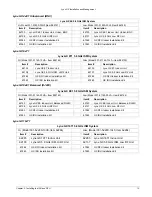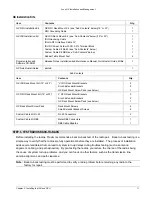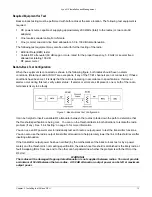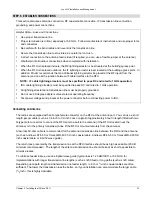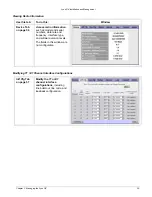
Lynx.GX Installation and Management
To prepare the RF transmission line or the RFU-to-IDU cable
(
experienced or skilled technician only
)
:
1. Cut a cable to the proper length (allowing some excess for service loops) that will connect the RFU to the
building egress point. Terminate both ends with TNC-Male connectors.
2. Repeat this process for the cable that will connect to the lightning surge protector outside the building
egress point and the equipment. Do not install the equipment end connector at this time, to facilitate pulling
the cable through ducts, trays, or conduit (as required) between the egress point and the IDU location.
3. Install the building egress lightning surge protector between the two RFU/IDU cable ends outside of the
building egress point, and ground the lightning surge protector to a proper broadband earth ground. The
proper installation and grounding of this lightning/surge protector is critical, since it is the “firewall” protecting
equipment and personnel inside the building from potentially lethal electrical storm power surges.
º
Pay close attention to the transmission line specifications for bend radius when installing.
º
Be careful not to kink, damage, or deform the transmission line in any way.
º
Support the transmission line in a tray on horizontal runs and by hangers on vertical runs. Space
hangers according to the manufacturer instructions.
4. Ground the transmission line using the appropriate cable/waveguide grounding kits per the cable/waveguide
manufacturer’s instructions. A minimum of three grounding points is recommended
at the antenna end of
the cable/waveguide, at the base of the tower, and at the equipment building egress point. In addition, long
transmission line runs should be grounded at least every 100 feet.
5. Install lightning protection devices, including proper grounding and termination to cables. There should
always be a lightning protection device at the egress point for whatever cables egress the building or
enclosure. For an all-indoor implementation, the in-line lightning protection device must be rated for the
operating frequency of the radio (5.8 GHz).
Lightning protection for the RFU-to-IDU connection portion of an outdoor implementation of the RFU must
be rated to 800 MHz and must be non-blocking to DC. Proxim recommends placing lightning arrestors near
the RFU and outside of the equipment building egress point for 2-piece systems. Lightning arrestors must
be grounded to a proper broadband earth ground in order to be effective. This means use of a low-
inductance ground strap or very short ground cable between the lightning protector and earth (not power
company) ground.
6. After installation, terminate the RF transmission line with an N-type (or appropriate) male connector or low-
loss adapter attached at the equipment end. For waveguide, this typically requires a CPR-to-N adapter.
Be sure to use manufacturer-specified connectors and termination tools, and follow termination instructions
precisely. Improper transmission line terminations can cause excess losses and reflections that can lead to
many problems with the system.
7. Prior to operation, check the electrical integrity of the transmission line, including all connectors, with a
simple DC check between the center conductor and outer conductor (this is not possible for waveguide,
which should be swept to assure transmission performance).
The transmission line ideally should be connected directly to the antenna at one end and to the radio antenna
port at the other end; however, short pigtail jumper cables may be required in order to avoid sharp bends in the
primary transmission line, or to limit stress on either connection.
Chapter 2. Installing the IDU and RFU
24

